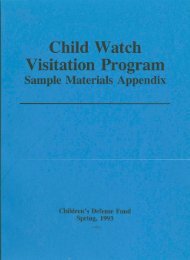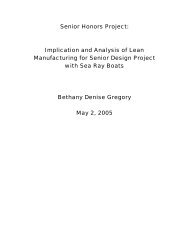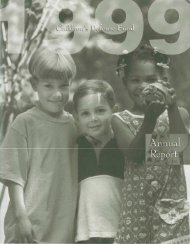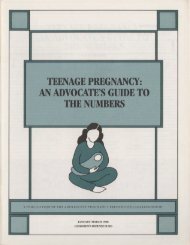child care - Digital Library Collections
child care - Digital Library Collections
child care - Digital Library Collections
Create successful ePaper yourself
Turn your PDF publications into a flip-book with our unique Google optimized e-Paper software.
THE STATE OF AMERICA'S CHILDREN YEARBOOK 1998<br />
gress. The partners eventually agreed to three desired<br />
outcomes: reductions in <strong>child</strong> abuse and neglect,<br />
less repeat abuse and neglect, and fewer serious<br />
injuries to <strong>child</strong>ren.<br />
The strategies now being undertaken to improve<br />
safety for <strong>child</strong>ren include a new "family<br />
solutions" approach for those working with families.<br />
Parents get help identifying triggering events<br />
that place their <strong>child</strong>ren at risk, and they learn<br />
new skills for better responding to these triggers.<br />
Family-group decisionmaking broadens the support<br />
network for some families in trouble. Informal<br />
neighborhood helpers work with other individuals,<br />
agencies, and community groups. A<br />
community-wide service network and a system of<br />
staff training will address families' individual<br />
needs for substance abuse services. At the same<br />
time, work groups cochaired by community leaders<br />
and agency representatives are examining the<br />
current <strong>child</strong> protection agency response to families<br />
in crisis. They are also pursuing new approaches<br />
to ensuring <strong>child</strong> safety and developing a<br />
decision-making mechanism that respects the different<br />
roles and responsibilities of the various partners.<br />
Communications and evaluation efforts are<br />
under way as well.<br />
Moving Forward: A 1998 Agenda<br />
for Action<br />
Keeping <strong>child</strong>ren safe depends on keeping them<br />
in nurturing families and communities. That<br />
will require action at the local, state, and nationallevels<br />
and partnerships among all those with<br />
a stake in protecting <strong>child</strong>ren-parents and other<br />
relatives, foster families and adoptive families, public<br />
and private <strong>child</strong>-serving agencies, community<br />
and business leaders, religious organizations, educators,<br />
and <strong>child</strong> advocates. It requires that we look<br />
holistically at what is jeopardizing families' abilities<br />
to protect their <strong>child</strong>ren, and at who can help to<br />
prevent those problems and build on families'<br />
strengths. No single agency alone can assume responsibitity<br />
for keeping <strong>child</strong>ren safe. Nor is there<br />
any single solution for keeping a <strong>child</strong> in a permanent<br />
family.<br />
During 1998 advocates at the state and local<br />
levels must:<br />
• Constantly seek better strategies to promote<br />
safety and permanence for <strong>child</strong>ren. Collect and<br />
establish basetine data so that the impact of<br />
the new Adoption and Safe Families Act can<br />
be assessed after a year and over the longer<br />
term. Identify effective strategies, focusing on<br />
what works best to treat <strong>child</strong>ren as individuals<br />
with unique circumstances and needs. Work to<br />
extend successful strategies to other communities<br />
and states, and explore new approaches.<br />
Evaluate the adequacy of existing resources<br />
and the extent to which they are being used<br />
efficiently; identify the gaps and craft the best<br />
case for new investments. Push for systemic<br />
reforms as well as services to reach more <strong>child</strong>ren<br />
and families.<br />
• Pay attention to special problems that threaten<br />
<strong>child</strong>ren's safety. Alcohol and drug abuse, domestic<br />
violence, and the mental health problems<br />
of parents can all endanger <strong>child</strong>ren. To<br />
ensure that families' needs are appropriately<br />
assessed and addressed, encourage collaboration<br />
between <strong>child</strong> welfare agencies and those<br />
that treat substance abuse, mental illness, and<br />
domestic violence. Include welfare and employment<br />
and training agencies too, since<br />
these same problems often pose serious barriers<br />
to employment for families required to<br />
work under the 1996 welfare law. Help the<br />
public to better understand the connections.<br />
Treating famities' problems and keeping parents<br />
on the employment track can keep them<br />
moving toward economic and social stability<br />
and prevent them from needing to seek help<br />
from the <strong>child</strong> welfare system.<br />
• Forge partnerships. Learn more about the community<br />
partnerships in Louisville and elsewhere,<br />
and consider how you might foster collaboration<br />
with the <strong>child</strong> protection agency in<br />
your communHy. Build on the work already<br />
done in some states to reach across agencies<br />
and into communities to implement the Promoting<br />
Safe and Stable Famities Program and<br />
74 CHILDREN'S DEFENSE FUND














